
views
Choosing a Mod Outfit for Women
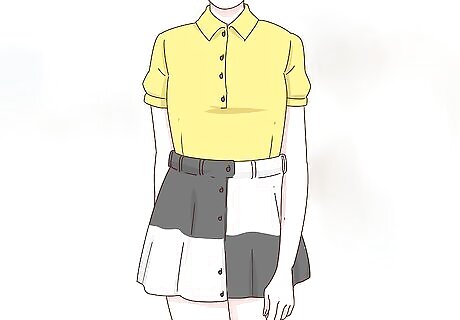
Choose clothes with bright colors and bold geometric patterns. Along with the rise of the pop art and modern art movements, a taste for bright colors emerged in the 1960s to counteract the mild, neutral color palette of 50s fashion. These bright colors were often combined with bold, sharp geometric patterns. Shirts with bright, contrasting colors used on the collars and cuffs were popular. For example, you could match a bright yellow top with a black and white geometric-print mini skirt.

Opt for a brightly-colored shift dress or mini skirt. Blocky shift dresses and mini-skirts that de-emphasized a woman’s figure were staples of the mod movement. High necklines, sleeveless cuts, and bright, solid colors were typical of 60s shift dresses. Mini skirts: A mini skirt hemline typically falls above the knee, somewhere around the mid-thigh. Many mini skirts were high-waisted, thanks to the influence of fashion icon Audrey Hepburn. 60s mini skirts were generally not figure-hugging; instead, they were pretty boxy. Additionally, plaid was a popular pattern for mini-skirts. Cut-outs: Large singular cut-outs in dresses, often just above the belly button or on the upper back, were popular and meant to be flirtatious.
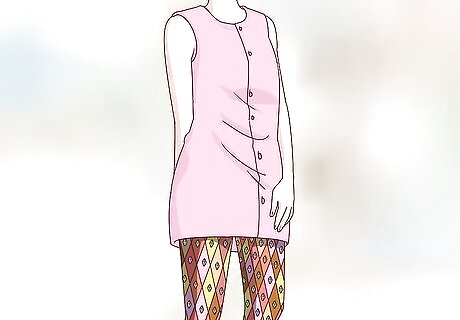
Match your dress with colorful patterned tights. With the rise of the mini skirt, tights featuring wild patterns became all the rage. Pair a solid-colored shift dress with bright, geometric-patterned tights for a classic mod combination. For example, you could wear a solid-colored pink shift dress with printed tights that have different colored diamonds on them.
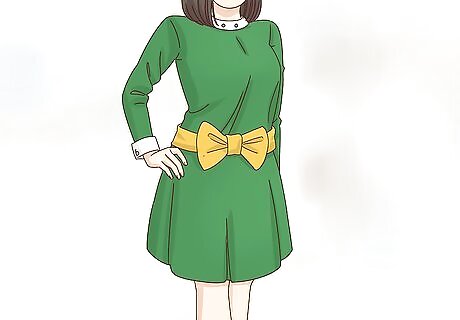
Look for tops with oversized collars and bows. Oversized detailing on a shirt or dress works to miniaturize your figure and make you appear smaller. It also channels the youthful spirit that was so sought after in the 60s. You could wear a shift dress with a large oversized collar, or a bow at the waist.
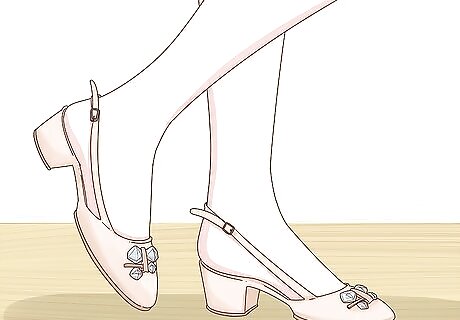
Go with low-block heels. Blocky heels with 1 to 2 in (2.5 to 5.1 cm) heels or loafers were among the most popular shoe choices for women in the 60s. Match your favorite low-block heel with tights or high-knee socks. Great for colder days, knee high boots with a lower heel are also a classic 60s fashion choice. White knee-high boots are often called “go-go boots.” Mary Jane heels were another low-block heeled shoe that worked to create a youthful look.
Assembling a Mod Outfit for Men
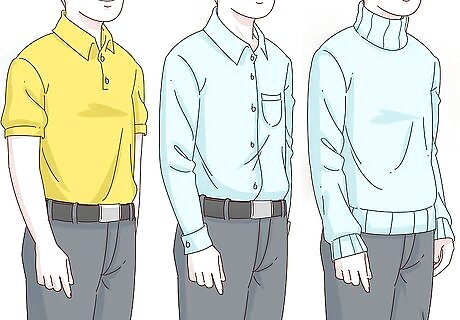
Start with a single-color polo, Oxford button-down shirt, or turtleneck. Look for shirts in pastel or neutral shades. These types of shirts can be great first layers underneath a sporty blazer, or they can be worn by themselves. Pastel blues and yellows were popular shirt color choices for men. The mod look for men is characterized by refinement, and the mod movement was remarkable in the way that it encouraged men to care about the clothes that they wore.
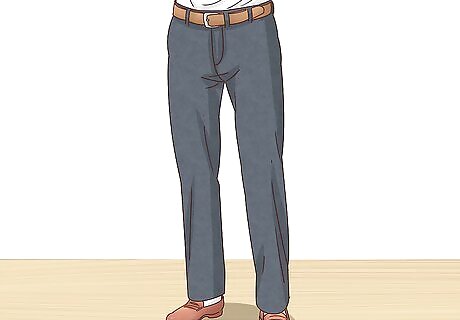
Opt for slim-fit pants with a lower waistline in a dark color. Choose a well-pressed pair of chinos or any pant with a tight fit around the thigh. Men’s pants in the 1960s became much tighter, and thus mod clothing for men was typically figure-flattering. Many 1960s men’s dress pants became more geometric in that they started to flare out slightly around the ankle. Find pants that have this slightly-flared cut to be extra-faithful to the 1960s mod look.

Wear a pea coat or three-button blazer over your shirt. Choose outerwear that’s made of a different fabric from your shirt and pants, such as tweed, to add texture to your look. Opt for a pea coat if you’re looking to go for a style that looks like it’s straight out of London. Mod outerwear typically came in dark colors, such as black or navy. Three-button blazers were emblematic of mod men’s fashion, and they distinguish this time period from others. London became an epicenter for fashion in the 1960s with the rise of the Beatles. Generally, any style that has origins in London is aligned with the mod look.
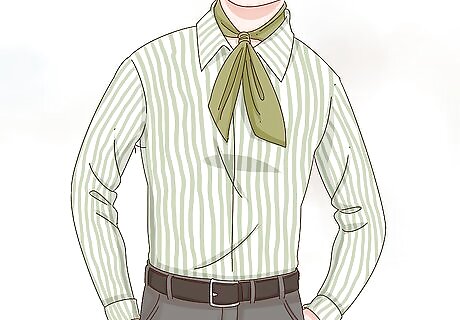
Look for wide ties and lapels. If you’re going to don a suit, be sure to choose a wider tie and lapel. Wider ties and lapels lend themselves to a more geometric look.

Choose a more formal shoe, such as winklepickers or Chelsea boots. Winklepickers are formal shoes with long-tipped toes that began increasing in popularity in the 1950s. Chelsea boots are cropped boots with low heels and rounded toes that were often sported by the Beatles. Desert boots are another great 60s style alternative to Chelsea boots. These boots are typically made from suede, and they are generally made to last for a long time.
Emulating Hippie Style for Women
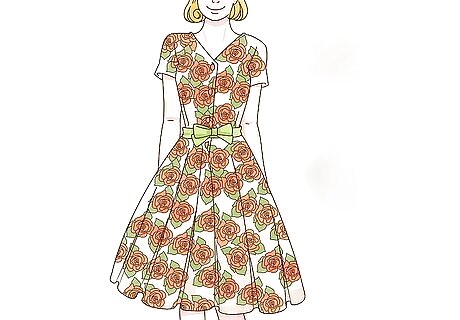
Choose a long, floral dress or skirt. Dresses and skirts for hippie women were generally loose, brightly-colored, and often adorned with prints of flowers to represent peace, love, and a return to nature. Many of these trends have persisted throughout the decades, so it is often not difficult to find these types of dresses in today’s boutiques and department stores.
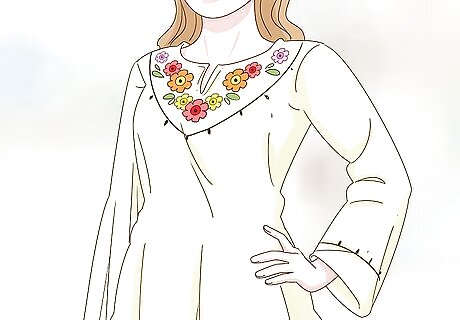
Opt for a peasant top. Peasant tops are shirts with wide necklines and long, flowing sleeves that cinch at the wrists. They are often embellished with prints and ribbons. Many white peasant tops are adorned with fringe and lace. White can also be easily paired with brighter bottoms and accessories.

Wear a suede or fringed vest over your top. Another staple of hippie outfits were vests — particularly vests made of natural materials like suede and featuring fringe. This fringe sometimes had beads attached to it, and overall worked to create a very natural, woodsy look.

Load up on the accessories, such as large jewelry and scarves. Unlike the clean simplicity of mod styles, hippie style was messy and loud, which often meant that outfits would involve lots of accessories. Some notable options are headbands, large glasses, head scarves, and any type of jewelry that makes percussion sounds or features peace signs. Embracing hippie culture is all about celebrating your individuality, so go with the accessories that you think best fit your personality!
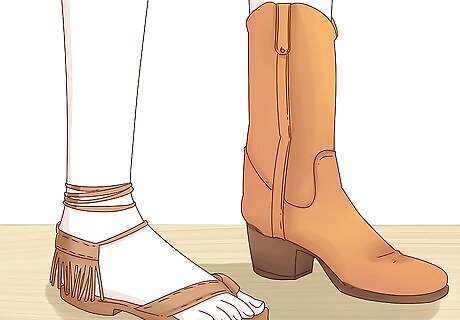
Go with leather sandals or cowboy boots for footwear. These were popular options for footwear due to their natural look. Alternatively, you can also ditch shoes entirely! This was not uncommon, especially at 1960s music festivals. However, be sure to wear shoes if you’re going to walk in any areas where there could potentially be broken glass or sharp objects on the ground. Also, be mindful of dress codes. Many schools, businesses, and public places will not allow people to walk around barefoot.
Creating a Hippie Look for Men
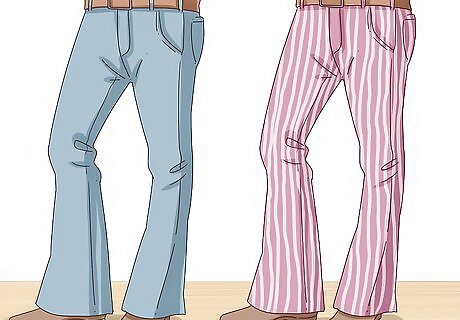
Wear a pair of bell-bottomed jeans or pants. Jeans became increasingly popular during this time period — particularly bell-bottomed jeans. Bell-bottoms are pants that are tight around the thighs, but flare out at the ankles. They were a traditionally feminine style, but they became stylish for men after musical icons like Jimi Hendrix appeared wearing them. Bell-bottoms have since gone out of style for men, but check local vintage stores, thrift stores, or garage sales if you’re looking to find a pair of them!

Choose a brightly-colored tye-dye shirt. Tie-dye refers to a specific way of dying a shirt that results in a kaleidoscope of colors. It was popularized by Janis Joplin, the Rolling Stones, Jimi Hendrix, and many other icons in the late 60s and came to symbolize freedom and experimentation. If you’re in a pinch and can’t go to a store to shop for tye-dye, you can easily make your own tye-dye shirt at home!
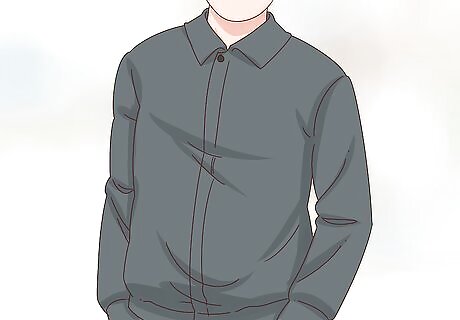
Opt for a jacket made of a natural material, like suede or leather. There was a big emphasis on clothing made from natural materials in hippie culture. Look for outerwear made of suede, leather, buckskin, denim, or some other naturally-produced cloth.

Go with a poncho with fringe for a classic 60s look. Large, colorful ponchos emerged onto the scene in the 1960s as a fashion staple for both men and women. These can be a comfortable way to keep warm while still sporting an emblematic 60s trend. Ponchos were not just a masculine style — they were suitable for both men and women.
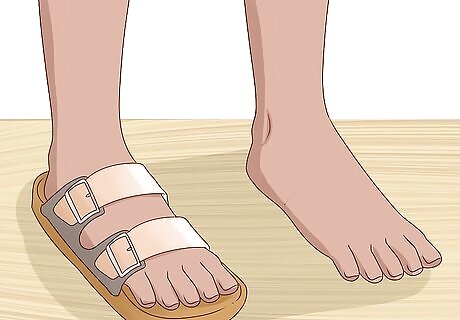
Wear sandals or go barefoot. Hippie footwear for men is very similar to that of women. Sandals made from natural materials, such as Birkenstock’s, were very popular. You can also go without shoes entirely, but make sure that it is safe to do so. EXPERT TIP Melynda Choothesa Melynda Choothesa Professional Stylist & Fashion Designer Melynda Choothesa is a Costume Designer, Wardrobe Stylist, and Art Director with over 10 years of fashion consulting experience. She has worked on creative direction for fashion shows, costume design, and personal wardrobe styling, both in Los Angeles, California and internationally for clients such as Akon, Kathy Ireland, and Aisha Tyler. She has an Associate of Arts in Fashion Design from Santa Monica College. Melynda Choothesa Melynda Choothesa Professional Stylist & Fashion Designer 60s styles still influence fashion today. Fashion designer Melynda Choothesa says: "The 1960s was a revival of the 20s, with a lot of boxy shapes and stylish—but not flashy—dresses. Then, that mod look was brought back in the 90s. Today, we see a mix of the original 60s mod and the 90s version. It keeps coming back, and now each designer just puts their own spin on it."

















Comments
0 comment